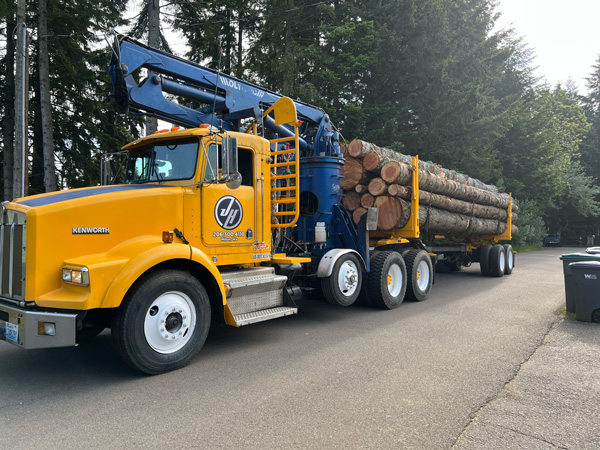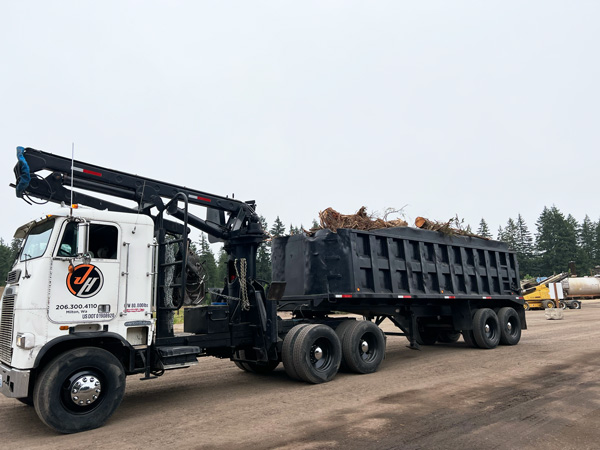We currently have a self-loading log truck and a self-loading end dump in the fleet:
Self-loader

A self-loader truck, also known as a self-loading log truck or self-loading log loader, is a specialized vehicle used for hauling logs in the forestry and timber industry. These trucks are designed to load logs onto the truck without the need for additional equipment or manual labor. Here’s how a self-loader truck works and why it can be beneficial to someone in the timber industry:
How a Self-Loader Truck Works:
- Hydraulic Arm or Grapple: The key component of a self-loader truck is its hydraulic arm or grapple. This arm is typically mounted on the rear of the truck and is equipped with a powerful hydraulic system.
- Control Panel: The operator controls the hydraulic arm using a control panel within the truck’s cab. This panel allows precise manipulation of the arm’s movements.
- Log Pickup: When the truck arrives at a logging site or timber yard, the hydraulic arm is extended, and the grapple is maneuvered to pick up logs. The grapple’s design allows it to securely grip multiple logs of varying sizes.
- Loading: Once the logs are securely grasped, the hydraulic arm lifts them off the ground and swings them over the truck’s cargo area.
- Dumping: The logs are then gently deposited onto the cargo area of the truck. Self-loader trucks typically have a hydraulically controlled, tilting bed, making it easy to release the logs in the desired location within the cargo area.
- Repeat: The process of picking up, loading, and dumping logs is repeated until the cargo area is filled.
Benefits of Hiring a Self-Loader Truck:
- Efficiency: Self-loader trucks significantly increase efficiency in the timber industry. They can load logs quickly and with minimal manual labor, reducing loading time and labor costs.
- Versatility: Self-loader trucks can handle logs of various sizes and weights, making them suitable for a wide range of logging and timber operations.
- Reduced Risk: Loading logs manually can be dangerous, but self-loader trucks reduce the risk of injuries associated with manual handling.
- Time Savings: The speed and precision of self-loading trucks can help expedite the logging process, allowing for faster turnaround times and increased productivity.
- Cost-Effective: While there is an initial investment in the truck and equipment, the long-term cost savings from reduced labor and increased productivity can make self-loader trucks a cost-effective choice.
- Less Environmental Impact: With efficient loading and hauling, self-loader trucks can reduce the impact on the environment by minimizing ground disturbance and damage to the surrounding ecosystem.
- Consistent Quality: Self-loading ensures that logs are stacked uniformly in the cargo area, reducing the risk of damage during transportation.
In summary, a self-loader truck for hauling logs is a specialized vehicle designed to streamline the process of loading and transporting logs. Its efficiency, versatility, and ability to reduce labor and time make it a valuable asset for individuals and companies involved in the timber industry. Whether you’re a timber mill owner or a forestry contractor, hiring a self-loader truck can lead to increased efficiency and cost savings in your operations.
Self-loader End Dump

A self-loading end dump truck is a specialized vehicle used for hauling stumps, brush, and other debris from construction sites, land clearing projects, or forestry operations. These trucks are designed to load material onto the truck without the need for additional equipment or manual labor. Here’s how a self-loading end dump truck works and why it can be beneficial to someone in the construction, land clearing, or forestry industry:
How a Self-Loading End Dump Truck Works:
- Hydraulic Loader: The key component of a self-loading end dump truck is its hydraulic loader, often equipped with a grapple, bucket, or clamshell attachment. This loader is typically mounted on the rear of the truck.
- Operator Controls: The truck’s operator controls the hydraulic loader from within the cab. The control panel allows precise manipulation of the loader’s movements, including raising, lowering, and opening or closing the grapple or bucket.
- Material Pickup: When the truck arrives at a site with stumps, brush, or debris to be hauled, the hydraulic loader is used to pick up the material. The loader’s grapple or bucket is maneuvered to grasp the material securely.
- Loading: Once the material is securely held by the grapple or bucket, the loader is raised, lifting the material off the ground. The loader can then be swung over and positioned directly above the cargo area of the truck.
- Dumping: The loader operator releases the grapple or bucket, allowing the material to fall into the cargo area. Self-loading end dump trucks typically have a hydraulically controlled, tilting bed, which makes it easy to dump the material in the desired location.
- Repeat: The process of picking up, loading, and dumping material can be repeated until the cargo area is filled.
Benefits of Hiring a Self-Loading End Dump Truck:
- Efficiency: Self-loading end dump trucks significantly increase efficiency in land clearing, construction, and forestry operations. They can load material quickly and with minimal manual labor, reducing loading time and labor costs.
- Versatility: These trucks can handle a wide range of materials, including stumps, brush, rocks, and debris, making them suitable for various applications.
- Reduced Labor: Using a self-loading end dump truck reduces the need for manual labor to load material onto the truck, which can be physically demanding and time-consuming.
- Time Savings: The speed and precision of self-loading end dump trucks can help expedite projects, leading to faster turnaround times and increased productivity.
- Cost-Effective: While there is an initial investment in the truck and equipment, the long-term cost savings from reduced labor and increased productivity can make self-loading end dump trucks a cost-effective choice.
- Reduced Environmental Impact: Self-loading end dump trucks can minimize ground disturbance and damage to the surrounding ecosystem because they require fewer passes to load and transport material.
- Consistent Quality: Self-loading ensures that material is loaded uniformly in the cargo area, reducing the risk of spillage or damage during transportation.
In summary, a self-loading end dump truck for hauling stumps and brush is a valuable asset for construction, land clearing, and forestry operations. Its efficiency, versatility, and ability to reduce labor and time make it a practical choice for those looking to streamline their material handling and hauling processes. Whether you’re a land clearing contractor or a construction site manager, hiring a self-loading end dump truck can lead to increased efficiency and cost savings in your operations.
